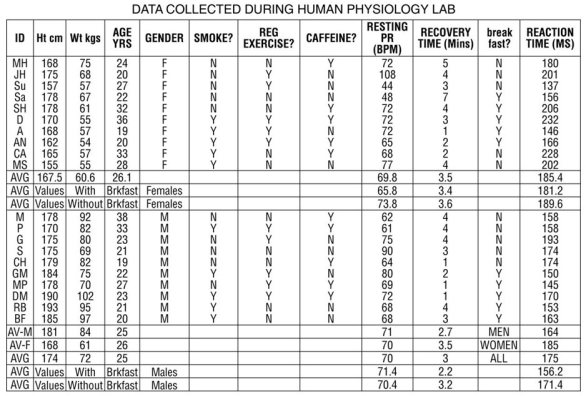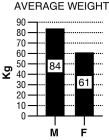Following is a table of data collected from one section of an 8 a.m.physiology lab.There were 20 students present,10 men and 10 women.Information collected from the students included their height,weight,age,and resting pulse rate.In addition,the students were surveyed to see if they smoked cigarettes,considered themselves "regular exercisers," if they had consumed caffeine the morning of the lab,and if they had eaten breakfast that day.A "y" or "n" (yes or no)was recorded to indicate their answers.Each student did "jumping jacks" for 5 minutes and recorded the time required to regain their resting heart rate,which is listed on the table as "recovery time." Finally,each student participated in an exercise designed to measure their reaction time (in milliseconds)in catching an object dropped by a lab partner according to specified criteria.Use this table to answer the following questions.Ignore statistical problems caused by small sample size,and so on.  Table 1.3
Table 1.3  For these questions,the data were separated and analyzed by gender.
For these questions,the data were separated and analyzed by gender.
-Refer to Table 1.3 and the bar graph.
A.Write a hypothesis regarding the effects of breakfast consumption on reaction time.
B.What is the dependent variable? What is the independent variable?
Definitions:
Trespass
The act of entering or remaining on someone else's property without permission, which can be a civil wrong or criminal offense.
Punitive Damages
Financial compensation awarded to a plaintiff beyond actual damages incurred, intended to punish the defendant for egregious behavior and deter future similar acts.
Confrontations
Direct encounters or conflicts between parties with opposing views or interests.
Passing-Off
An illegal act of misrepresenting one's own goods or services as those of another.
Q1: Which of the following is not an
Q5: When an employee embezzles company funds from
Q13: How many grams of NaCl,m.w.58.5 daltons,are the
Q19: This particle has a charge of -1
Q19: Management's report on internal controls must include
Q44: Which of the following statements is generally
Q44: You are doing an experiment to determine
Q77: A positively charged ion is called a(n)<br>A)
Q101: Polymers are a typical formation of _
Q103: in one side of a cell and